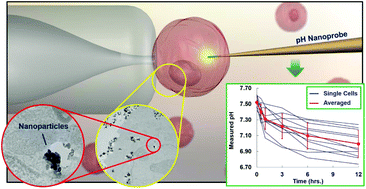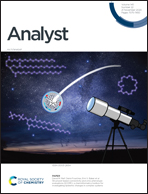Unveil early-stage nanocytotoxicity by a label-free single cell pH nanoprobe†
Abstract
Single-cell analysis is an emerging research area that aims to reveal delicate cellular status and underlying mechanisms by conquering the intercellular heterogeneity. Current single-cell research methods, however, are highly dependent on cell-destructive protocols and cannot sequentially display the progress of cellular events. A recently developed pH nanoprobe in our lab conceptually showed its ability to detect intracellular pH (pHi) without cell labeling or disruption. In the present study, we took the cytotoxicity of nanoparticles (NPs) as a typical example of cell heterogeneity, to testify the practicality of the pH nanoprobe in interpreting cell status. Three types of NPs (CeO2, TiO2, and SiO2) were employed to generate varied toxic effects. Results showed that the traditional assays – including cell viability, intracellular ROS generation, and mitochondrial inner membrane depolarization – not only failed to report the nanotoxicity accurately and timely, but also drew confusing or misleading conclusions. The pH nanoprobe revealed explicit pHi changes induced by the NPs, which corresponded well with the cell damages found by the transmission electron microscopic (TEM) imaging. Besides, our results unveiled an unexpectedly devastating effect of SiO2 NPs on cells during the early stage NP-cell interaction. The developed novel pH nanoprobe demonstrated a rapid sensing capability at single-cell resolution with minimum invasiveness. Therefore, it may become a promising alternative for a wide range of applications in areas such as single-cell research and precision medicine.



 Please wait while we load your content...
Please wait while we load your content...